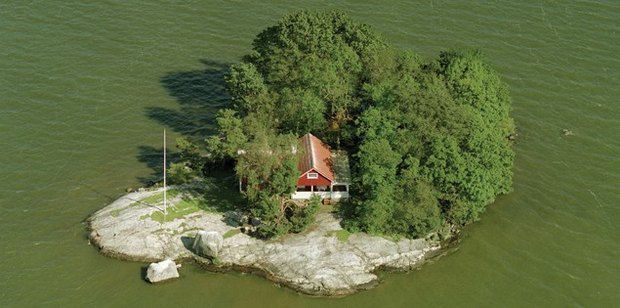
The dream? A house of your own, an island of your own? In this case from the lake Mälaren in Sweden.
Photo: Lars Bygdemark, SCANPIX
The dynamic character of the second home, in particular the changing relationship between the first and second homes also makes identification and measurement issues difficult. Recently, some Nordic geographers have instead taken to define second homes in terms of their structural form and mobility into three distinct categories: stationary (cottages and houses); semi-mobile (such as trailers and recreational vehicles), and fully mobile (such as sailing boats).
Data availability usually confines definitional and distributional considerations to the first of these three types, not least since second homes first became an item in Nordic national censuses in the early 1970s.
Finland
In Finland, the1970 Census was the first occasion when data on second homes was obtained at the national level. The number of second homes then amounted to some 176,000. During the 1980s the construction of recreational homes was particularly significant, and by 1990 the number had more than doubled to 368,000. The pace of expansion has slackened somewhat since then and currently stands at some 4000 new units per year. As of 2006, the number of second homes stood at 475,000.
Since 1990, the total number of second homes has seen the largest increase in the northern part of the country (Lappi, Kainuu and Keski Pohjanmaa, Lapland, Kajanaland, Mellersta Österbotten. In all of these landscapes, the number of second homes increased by more than 44 per cent over the period 1990-2006.
Sweden
Compared with Finland, second home development in Sweden took an early lead. In Sweden, the total number of second homes increased from 200,000 to 500,000 from 1950 to 1970, though the increase in the number of second homes has remained less dramatic since then. The geographical distribution of second homes has however undergone a significant shift during the last generation(s), as regular dwellings in rural areas have been progressively transformed into recreational homes while holiday homes in urban areas have been transformed into permanent homes.
Norway
In Norway, the number of second homes almost doubled from 1970 to 2000 (from 200,000 to 375,000), and the growth pattern continues with some 6,000-8,000 new recreational homes being built every year. Although the process of urbanisation continues in Norway as in Sweden, the conversion of second homes into permanent ones is by no means as manifest in Norway as in Sweden. Most second homes were constructed for this purpose, and as of 2004, a mere 6.5 per cent of the second home stock was made up of converted farm houses or permanent dwellings. Most new holiday homes are being erected in specially laid out areas. These areas come with a well-developed infrastructure, such as standard access to water and electricity.
Iceland
In Iceland, the recent economic boom can be identified via a sharp relative increase in the number of second homes. Since 1997, the number of residential dwellings has increased by more than a third, and stood at some 10,400 in April 2006. These second homes are strongly concentrated in a handful of municipalities located within a 150 kilometre radius of Reykjavik. In fact, six municipalities together host more than 55 per cent of all second homes in Iceland.
Denmark
In Denmark, one estimate put the number of second homes (in 1960) at 50,000-60,000. This number increased significantly from 1960 to 1975, when the number of summer houses stood at some 150,000. Since then, the number of second homes and summer houses in Denmark has increased more slowly. The first wave of second homes were built in the greater Copenhagen area (up to 1950), while the major building boost in the last 50 years has come in the North Jutland, Århus and Storstrøms amt. Currently, these summer houses are concentrated in coastal areas mainly on the western and northern coasts of Jutland and on the north coast of Zealand. The uses of second homes are more restricted in Denmark than in the other Nordic countries.
A further distinction separating Denmark from the other Nordic countries is that the categorisation of second home status can be undertaken in relation to the property's usage. While in the Nordic context second homes are traditionally used, in the main, as a recreational or second home for the owners and their immediate family, summer houses in Denmark are also rented out on a commercial basis or used as permanent homes.
In a 2000 study of the Danish summer house landscape, about three-quarters of all summer houses were estimated to be in traditional use, while a little more than two-fifths were mainly being rented out as income-generating dwellings. Almost one in ten summer houses were used year round, on a permanent basis.
Combined, the five Nordic countries could boast a stock of some 1 3/4 million second homes in 2006, or 72 per 1000 inhabitants: See table 1, p 12.
International comparisons on second-home ownership illustrates that, in the Nordic countries, second-home ownership is much more common than elsewhere. Studies published during the last 3-4 years moreover show that an estimated 6 per cent of all households owned second homes in the USA, while 14 per cent of households in the Canadian province of Quebec and 17 per cent of Australian households did so. In the continental European context, 15 per cent of households in Spain, less than 2 per cent of Dutch and British households, and less than 1 per cent of German households are second-home owners. These European statistics however also include allotments (kolonihaver).

Somebody likes it dense? Second homes at Laholm in Southern Sweden.
Photo: Lars Bygdemark, SCANPIX

Click to view larger image.
By Jon M. Steineke